The ongoing (at press time) environmental disaster in the Gulf of Mexico caused by the explosion of the Deepwater Horizon drilling platform is certainly an eco-disaster of epic proportions, but how does it rank with the worst oil spills in history? Counting down the past half-century’s 13 biggest oil spills – on land and sea – reveals a stunning succession of sick slicks along with the likelihood of more to come.
#13 - Exxon Valdez: 35,000 tons
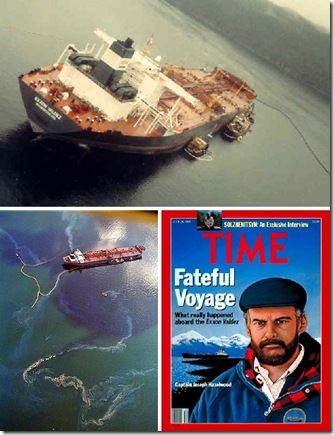
The worst oil spill in U.S. history began the night of March 23, 1989, when Captain Joseph Hazelwood allegedly decided to chase away both boredom and bitterly cold temperatures with a bottle of booze. As his ship, the 1,000 ft long supertanker Exxon Valdez, was traversing Alaska’s Prince William Sound outside designated shipping lanes, its hull was split open by an underwater reef. Over 10 million gallons of heavy crude oil spilled into the sound’s cool, clear water; quickly covering miles of pristine shoreline in black goop rendered tar-like by the frigid climate.
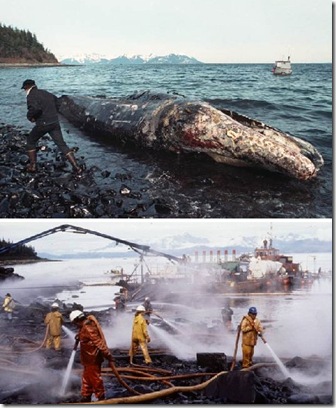
Though it ranks only 53rd on the all-time list of largest oil spills by quantity, the Exxon Valdez spill had a huge impact on American politics, pop culture and the environmental movement – not to mention the fragile ecosystem of Alaska’s southern coastline. Images of dead and dying wildlife, along with efforts to rescue survivors, were widely publicized in the media. Surprisingly, the former Exxon Valdez is still a working ship today – converted to an ore carrier, it’s owned by a Hong Kong shipping line and goes under the name Dong Fang Ocean.
#12 - Torrey Canyon: 123,000 tons
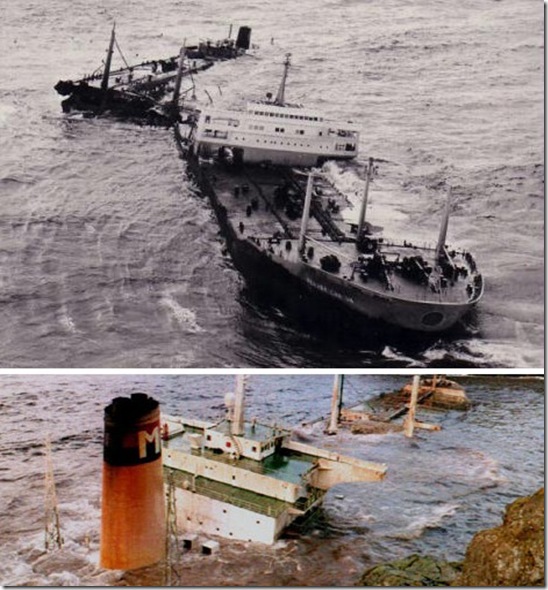
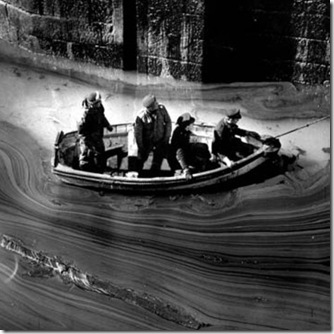
One could mark the beginning of the modern era of monstrously large oil spills with the March 18, 1967, wreck of the Torrey Canyon. After running aground in rough seas off the Scilly Islands near Cornwall, England, the tanker spilled 38 million gallons (about 123,000 tons) of crude oil before breaking up and sinking. Reports given to investigators after the accident claimed the captain diverted from normal sea lanes in order to arrive in port faster.
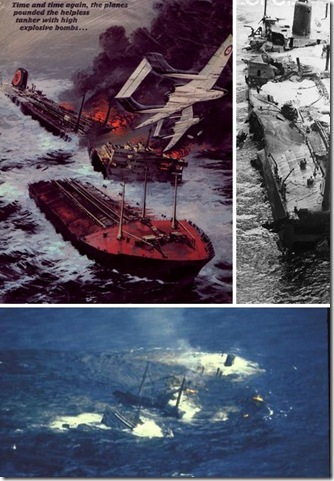
The British government was ill prepared for the world’s first major oil tanker disaster. After deciding to set the huge surface slick ablaze, Prime Minister Harold Wilson ordered repeated sorties by RAF jets who dropped flaming napalm and 42 1,000-lb bombs. Over 10,000 tons of harsh, toxic solvents and detergents were poured onto the seaborne slick and oil-mired beaches in England and France, causing additional long-term damage to land and sea wildlife.
#11 - The Odyssey: 132,000 tons
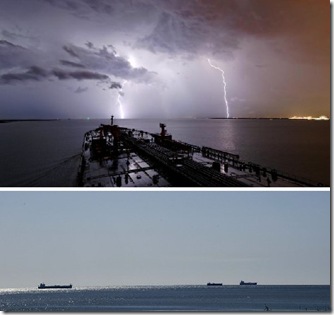
The North Atlantic ocean off Canada’s eastern province of Nova Scotia is hardly a peaceful place, especially in late autumn, but that’s where the American-owned oil tanker Odyssey found itself in November of 1988. The tanker was approximately 700 miles off the Nova Scotia coast when it suddenly exploded and broke apart. The flames set the ship’s cargo – 132,000 tons of crude oil – ablaze, which in retrospect might have been a blessing: no oil washed up on the Nova Scotia coast in the weeks that followed.
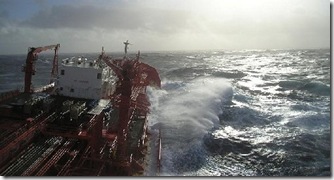 Hazardous weather conditions in the Atlantic prevented the Canadian Coast Guard from reaching the vicinity of The Odyssey’s last reported position, and by the time units finally arrived most of the oil had burned up.
Hazardous weather conditions in the Atlantic prevented the Canadian Coast Guard from reaching the vicinity of The Odyssey’s last reported position, and by the time units finally arrived most of the oil had burned up.
#10 - M/T Haven: 145,000 tons
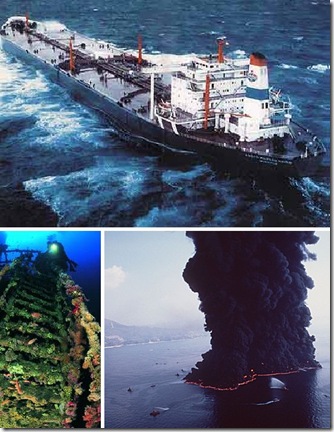
The M/T Haven was formerly known as the Amoco Milford Haven, sister ship to the Amoco Cadiz (more on that later). Classified as a VLCC (Very Large Crude Carrier), the 233,690 ton tanker was loaded with one million barrels of oil when an explosion ripped it apart, killing 6 crew members and spilling 145,000 tons of heavy crude into the Mediterranean Sea off the coast of Genoa, Italy. The blast set the massive oil slick ablaze and about 70 percent was consumed in the ensuing fire.
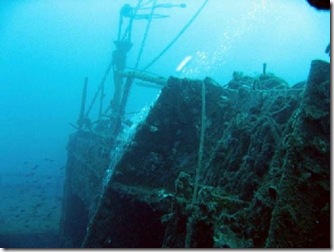
It took 3 days for the M/T Haven to sink and a dozen years for the sun-drenched Italian and French coasts to recover from horrific pollution. Investigators later discovered that some of the oil had sunk to the ocean floor over 1,600 feet deep, where it may remain for decades or even centuries.
#9 - Amoco Cadiz: 223,000 tons
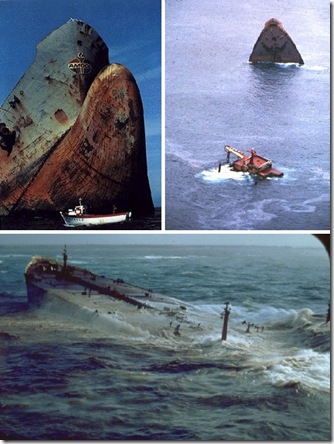
The M/T Haven’s sister ship, the Amoco Cadiz, is infamous for the extreme environmental damage caused when it struck the Portsall Rocks off the coast of Brittany, France, on March 16 of 1978. Handling sluggishly with a cargo of 1,604,500 barrels of oil, the ship may have been struck by a giant rogue wave that damaged its rudder and left it unresponsive to commands from the helm. collision with the 90-ft deep rocks broke the tanker’s back, splitting it in two and quickly sending it to the depths – but by that time, the ship’s entire cargo had spilled into the sea.
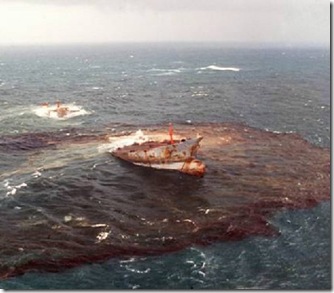
Prevailing winds and tidal action drove the oil onto almost 200 miles of French coastline. Wildlife losses were widespread and extensive, amounting to 20,000 seabirds, 9,000 tons of oysters and millions of bottom-dwelling creatures like starfish and sea urchins.
#8 - Castillo de Bellver: 252,000 tons
The August 1983 saga of the Castillo de Bellver reads much like that of The Odyssey, in that wind and weather conditions in the area of the disaster kept oil off beaches and coastlines. Like The Odyssey, the Castillo de Bellver exploded following a fire that raged out of control. Unlike The Odyssey however, the Castillo de Bellver was a mere 24 miles off the popular bathing beaches of Cape Town, South Africa, when the incident occurred.
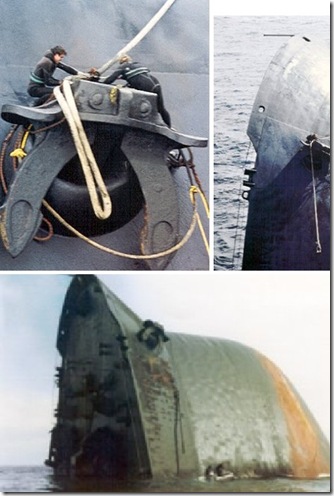
The Castillo de Bellver disaster is the largest oil spill to occur in South African waters. While isolated environmental damage was noted at several points around Cape Town, the bulk of the escaped oil dissipated quickly due to offshore winds, choppy wave action and fast currents in the historically treacherous seas around the Cape of Good Hope. Helping matters was the fact that the bow section of the capsized tanker was towed into deep ocean water and scuttled using explosives.
#7 - Ekofisk Oil Field: 263,000 tons

An eerie prelude to the The Deepwater Horizon disaster occurred 33 years ago in the North Sea between Norway and the UK. The blowout of well Phillips Petroleum’s B-14 well in the Norwegian Ekofisk field saw 81 million gallons of oil leak into the sea over an 8-day period, until the well was finally capped on April 30. The oil & gas blowout did not destroy the drilling platform but a hot mixture of oil, mud and water shot 180 feet into the air. According to the Norwegian State Pollution Control Board, “no major ecological damage resulted from the spill.”
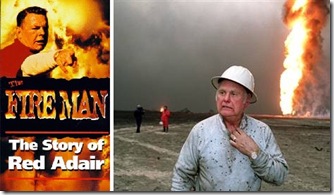
Famed American oil well “hellfighter” Red Adair (1915-2004) assisted in capping the runaway well after being contracted by Phillips. It was later determined that the accident was wholly preventable: the mechanical device that should have prevented a blowout (called a “blowout preventer”)had been installed on the wellhead upside down at a previous maintenance procedure.
#6 - ABT Summer: 260,000 tons
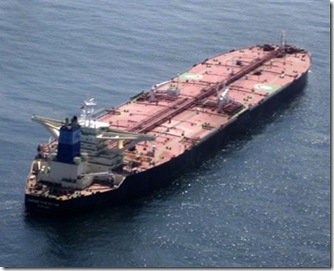
One of the largest oil spills at sea is also one of the least known: the ABT Summer, a tanker which sank in the South Atlantic ocean approximately 900 miles west of the coast of Angola. The ABT Summer had taken on a load of 260,000 tons of Iranian heavy crude oil at that country’s Kharg Island facility in early May of 1991. Its final destination was Rotterdam, The Netherlands, by way of the Cape of Good Hope.
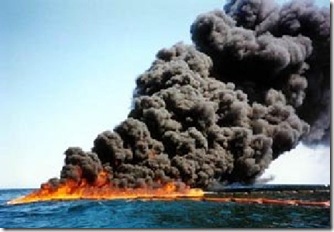
At some point after the ABT Summer rounded the southern tip of Africa and began the run up Africa’s Atlantic seaboard, her hold sprung a leak and the leak soon caught fire. On the 28th of May, the fire triggered a massive explosion that destroyed the ship and killed 5 of her 32-man crew. By June 1, most of the surface oil had burned and remnants of the ship had sunk to the ocean floor. Subsequent efforts to locate the wreckage have so far proved fruitless.
#5 - Nowruz Oil Field: 260,000 tons
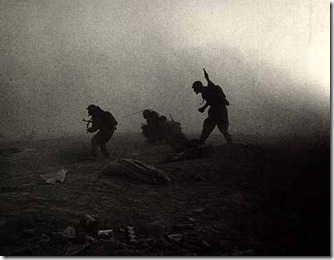
Iran’s Nowruz oil field was caught in the crossfire of the Iran-Iraq war several times, resulting not only in loss of life but the spilling of huge amounts of oil. 1983 was an especially bad year to be working at the field. On February 10, an oil tanker collided with a loading platform causing a spill of 1,500 barrels per day. The next month, the platform was attacked by Iraqi helicopters whose munitions set the slick aflame. As the area was then a war zone, it took 6 months to cap the burning, still spouting well.
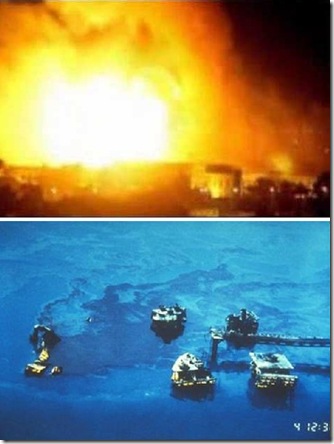
Another Iraqi helicopter attack on a nearby oil platform caused a separate spill that wasn’t capped until May of 1985 – over two years later! The latter incident alone caused the loss of 733,000 barrels (100,000 tons) of oil. In total, 80 million gallons (about 260,000 tons) of oil were spilled at the Nowruz oil field and 20 workers were killed trying to cap the wells.
#4 - Fergana Valley: 285,000 tons

Oil spills don’t always occur when oil tankers capsize or drilling platforms malfunction. Sometimes the spills occur inland, far from any ocean or coastline… though the environmental effect is just as ghastly, if not more. Such is the case of the Fergana Valley oil spill, where in 1992 one of the largest inland oil spills in recorded history took place.
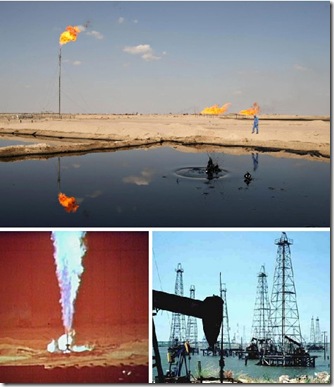
The Fergana Valley, which straddles the border between Uzbekistan and Kyrgyzstan, is a densely populated, exceptionally fertile agricultural region inhabited since prehistory. In more recent times it was found to sit atop a group of oil deposits which have since been profitably exploited – but not always properly. On March 2, 1992, an oil well in the Fergana Valley suffered a mechanical breakdown and blowout; what eventually amounted to 88 million gallons or approximately 285,000 tons of oil flowed out of the well and into the valley.
#3 - Atlantic Empress/Aegean Captain: 287,000 tons

On July 19, 1979, the Caribbean Sea off the Venezuelan coast near the island of Tobago was the site of a severe tropical storm. Caught in that storm were two ships: the Atlantic Empress and the Aegean Captain. A collision between the Atlantic Empress – a fully-loaded supertanker – and the Aegean Captain resulted in a huge explosion and the world’s largest ship-based oil spill to date. About 2.2 million barrels of crude oil spilled into Tobago’s brilliant blue waters after the collision, much of which was consumed in an exceptionally smokey blaze.
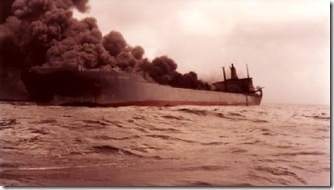
The 1970s were the worst decade in human history when it comes to marine oil spills; if the damage has been mitigated in subsequent decades we can put it down to improved tanker designs – double hulls, for example – that would have prevented accidents like those suffered by the Exxon Valdez and the Amoco Cadiz. They won’t prevent human error, unfortunately.
#2 - Ixtoc I Oil Well: 454,000 tons
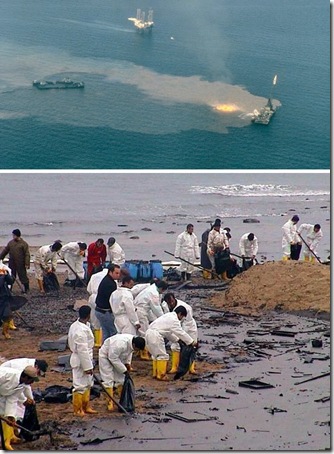
The world’s worst single-source oil spill began on June 3, 1979 when the Ixtoc I oil well exploded, spewing the first of over 140 million gallons of oil into the Bay of Campeche off Ciudad del Carmen, Mexico. The scope of the disaster was assured when, just after the initial blowout, the oil drilling platform caught fire and collapsed. Oil continued to spill from the well into the Gulf of Mexico until March of 1980, when the well was finally capped.
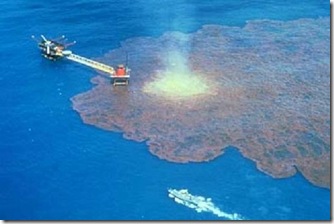
Prevailing westerly winds and a series of favorable storms kept much of the oil spill off the beaches of eastern Mexico and southeastern Texas, though oil did foul beaches on Texas’ South Padre Island in the fall of 1979. The scope of the environmental impact during and following the Ixtoc 1 spill, especially when the immense volume of oil spilled is considered, gives one hope for the future of America’s gulf coast in 2010 and for the years to come.
#1 - Gulf War Oil Spill: 1,360,000 -1,500,000 tons
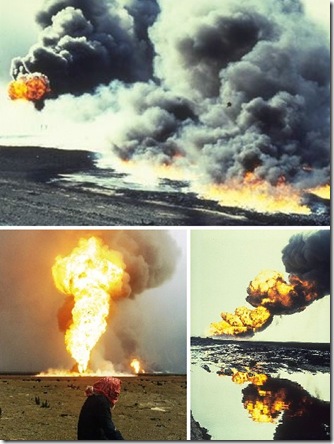
The world’s worst oil spill – by far – took place in southern Kuwait during the First Gulf War. In late January of 1991, Iraqi forces directed by Saddam Hussein and the Baathist leadership set about opening valves on oil pipelines, oil wells and even on moored oil tankers as a last-gasp effort to forestall military defeat. It’s estimated that between January 23 and 27, at least 240 million gallons (and possibly as much as 460 million gallons) of crude oil flowed onto dry land and into the Persian Gulf.
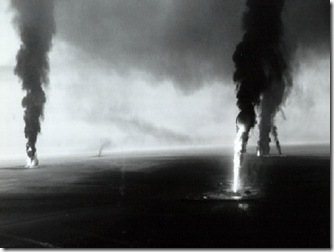
U.S. warplanes bombed pipelines and pipe systems on January to stop the flow of oil.
The worst oil spill in history, the Gulf War oil spill spewed an estimated 8 million barrels of oil into the Persian Gulf after Iraqi forces opened valves of oil wells and pipelines as they retreated from Kuwait in 1991. The oil slick reached a maximum size of 101 miles by 42 miles and was five inches thick.
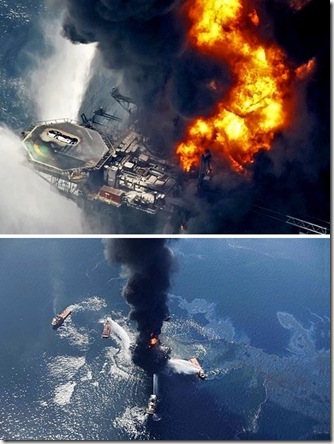
And… we’re not done yet, folks! On April 20, 2010, the semi-submersible drilling rig Deepwater Horizon exploded, then sank into the Gulf of Mexico 2 days later with the loss of 11 lives. The force of the explosion and sinking tore lose the 5,000-ft long riser pipe that connects the rig to the wellhead, and the wellhead itself began leaking oil. It was quickly determined that up to 5,000 barrels (200,000 gallons, or 10,000 tons) of oil per day were leaking into the Gulf, setting the stage for an environmental disaster that could rival that of the Exxon Valdez 30 years ago. As for the quantity of oil that will eventually be spilled, we’ll remind you that it took 9 months for Ixtoc 1 to be capped… you do the math.


0 comments: on "Counting Down The 13 Worst Oil Spills"
Post a Comment